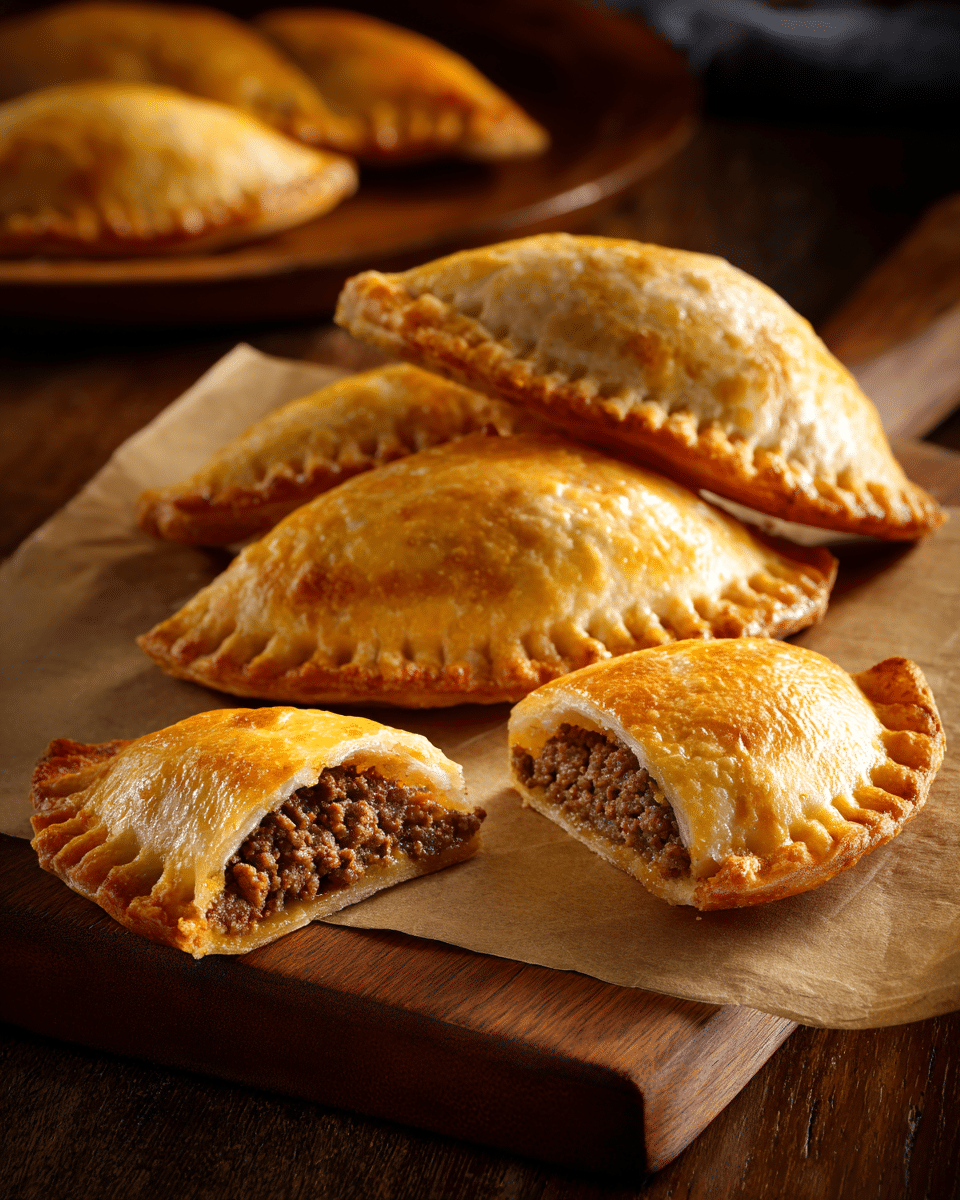Empanadas de Carne are a beloved Latin American dish known for their flaky pastry and savory meat filling. These handheld pockets are typically filled with seasoned ground beef, onions, olives, and sometimes hard-boiled eggs, creating a flavorful combination with a satisfying bite. Ideal as a hearty snack, lunch, or dinner, empanadas are also perfect for parties and gatherings.
FULL RECIPE
Ingredients
1.For the Dough:
- 3 cups all-purpose flour
- ½ cup unsalted butter, cold and cubed
- 1 egg
- ½ teaspoon salt
- ¾ cup cold water (more if needed)
2.For the Filling:
- 1 tablespoon olive oil
- 1 medium onion, finely chopped
- 2 cloves garlic, minced
- 1 pound ground beef
- 1 teaspoon ground cumin
- 1 teaspoon paprika
- ½ teaspoon ground black pepper
- ½ teaspoon salt (adjust to taste)
- ¼ cup green olives, chopped
- 2 hard-boiled eggs, chopped
- 2 tablespoons tomato paste
- 2 tablespoons beef broth or water
3.For Assembly:
- 1 egg (for egg wash)
- Extra flour (for dusting)
Directions
- Prepare the Dough: In a large bowl, combine the flour and salt. Cut in the cold butter using a pastry cutter or your fingers until the mixture resembles coarse crumbs. Beat the egg and add it to the flour mixture, followed by the cold water, a little at a time, mixing until the dough comes together. Knead briefly, wrap in plastic, and chill in the refrigerator for 30 minutes.
- Make the Filling: Heat olive oil in a skillet over medium heat. Add the onion and garlic, sautéing until translucent. Add the ground beef and cook until browned, breaking it up as it cooks. Stir in cumin, paprika, black pepper, and salt. Add tomato paste, broth, olives, and chopped boiled eggs. Mix well and simmer for 5 minutes. Remove from heat and let cool.
- Roll and Fill: Preheat oven to 375°F (190°C). On a lightly floured surface, roll out the dough to about ⅛-inch thickness. Cut into 5 to 6-inch circles. Place 1 to 2 tablespoons of the meat filling in the center of each circle. Fold over into a half-moon shape and crimp the edges with a fork to seal.
- Egg Wash and Bake: Place the empanadas on a baking sheet lined with parchment paper. Beat one egg and brush the tops of the empanadas with it for a golden finish. Bake for 25–30 minutes, or until golden brown.
- Cool and Serve: Let the empanadas cool slightly before serving. Enjoy warm or at room temperature.
Nutrition Facts
- Calories: 280
- Total Fat: 16g
- Saturated Fat: 6g
- Cholesterol: 60mg
- Sodium: 340mg
- Total Carbohydrates: 24g
- Dietary Fiber: 1g
- Sugars: 1g
- Protein: 10g
History and Origin of Empanadas de Carne
Empanadas de Carne trace their roots to Spain and Portugal, where the concept of enclosing savory fillings in dough dates back centuries. The name “empanada” comes from the Spanish verb empanar, meaning “to wrap in bread.” As Spanish explorers and colonizers traveled to Latin America, they brought the recipe with them, where it evolved to incorporate local flavors and ingredients. Today, empanadas are a cultural staple across many Latin American countries, each adding their unique twist to the meat-filled pastry.
Cultural Significance and Popularity
Empanadas hold a special place in Latin American cuisine and are often enjoyed during festivals, family gatherings, and street fairs. They are appreciated not only for their delicious flavor but also for their portability, making them a popular snack or meal on the go. In many cultures, empanadas are a symbol of sharing and hospitality, commonly served to guests as a warm, comforting treat.
Nutritional Benefits of Empanadas de Carne
While empanadas are typically considered indulgent, they do offer nutritional benefits when made with wholesome ingredients. The ground beef filling provides a good source of protein, iron, and essential vitamins like B12, which support muscle function and energy levels. When paired with a balanced side such as a fresh salad, empanadas can fit well into a nutritious meal plan. Using lean beef and moderate amounts of oil can help control fat content.
Variations and Regional Differences
Empanadas de Carne have countless variations depending on the region. In Argentina, for instance, empanadas often include raisins and boiled eggs in the filling, adding a sweet and savory contrast. Chilean versions might incorporate cumin and olives, while in Colombia, the dough is sometimes made with cornmeal. Vegetarian and seafood fillings have also become popular, showing how versatile empanadas can be to accommodate different tastes and dietary preferences.
Dough Options and Techniques
The dough for empanadas plays a crucial role in the final texture. Traditional doughs are made with flour, butter, and water to achieve a tender, flaky crust. Some recipes call for baking powder or lard for added flakiness. Alternative doughs using cornmeal or whole wheat flour offer different textures and flavors. Mastering the right dough consistency and rolling technique ensures the empanadas hold their shape and bake evenly without becoming soggy or dry.
Serving Suggestions and Pairings
Empanadas de Carne can be served as a main dish, appetizer, or snack. They pair wonderfully with a variety of accompaniments such as chimichurri sauce, a tangy and herbaceous condiment from Argentina, or a simple salsa verde. A crisp green salad, pickled vegetables, or black beans and rice also complement the rich meat filling well, balancing the meal with fresh and vibrant flavors.
Tips for Making Perfect Empanadas
Achieving the perfect empanada requires attention to dough thickness, sealing, and baking temperature. Rolling the dough too thin can lead to breakage and filling leakage, while too thick can make the pastry doughy and heavy. Properly sealing the edges with a fork or crimping technique prevents the filling from spilling out during baking. Using an egg wash not only enhances the golden color but also adds a slight gloss, making the empanadas more visually appealing.
Storage and Reheating Advice
Empanadas are best enjoyed fresh out of the oven, but they can be stored and reheated successfully. Allow them to cool completely before refrigerating in an airtight container for up to three days. For longer storage, freeze uncooked empanadas on a tray before transferring to a freezer bag; they can then be baked directly from frozen, adding a few extra minutes to the cooking time. Reheating in the oven or air fryer helps maintain their crisp texture better than microwaving.
Healthier Alternatives and Modifications
To make empanadas lighter, several modifications can be made. Using lean ground beef or substituting with ground turkey or chicken reduces saturated fat. Baking instead of frying cuts down on added oils and calories. Incorporating vegetables like bell peppers, spinach, or mushrooms into the filling can increase fiber and nutrient content. Additionally, whole wheat or gluten-free flour options for the dough cater to dietary restrictions while still producing tasty results.
Popular Occasions to Serve Empanadas
Empanadas de Carne are incredibly versatile and fit many occasions, from casual family dinners to festive celebrations. They are often served during holidays, such as Christmas and national festivals, and are a common offering at potlucks and picnics due to their convenience. Their handheld nature makes them an ideal party food, and they are frequently featured in street food markets across Latin America and beyond.
Conclusion
Empanadas de Carne remain a timeless and beloved dish thanks to their rich flavors, satisfying textures, and cultural heritage. Whether enjoyed as a quick snack or a hearty meal, their versatility allows them to be adapted to various tastes and dietary needs. By exploring different doughs, fillings, and serving styles, home cooks can make this classic Latin American pastry their own, sharing a piece of culinary tradition with friends and family.






